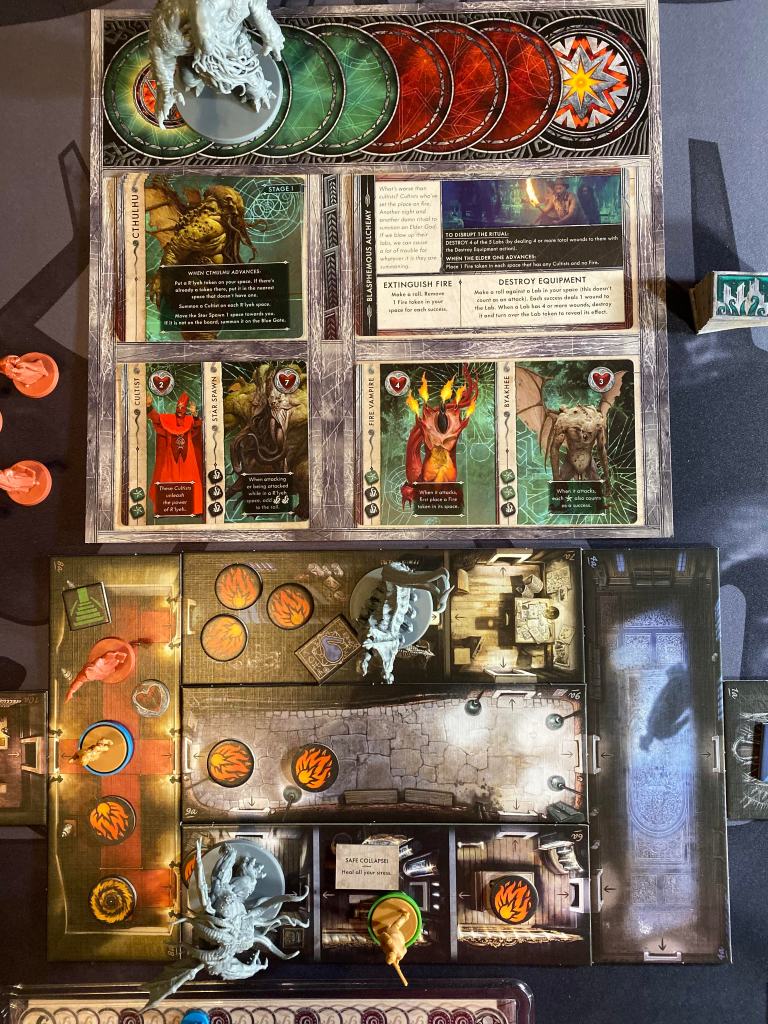
1-4 players, Cooperative, Action Selection Elder-One Brawl
Designer: Rob Daviau, Eric Lang
Artwork: Karl Kopinski, Edgar Skomorowski, Adrian Smith
Publisher: CMON
Release Year: 2019
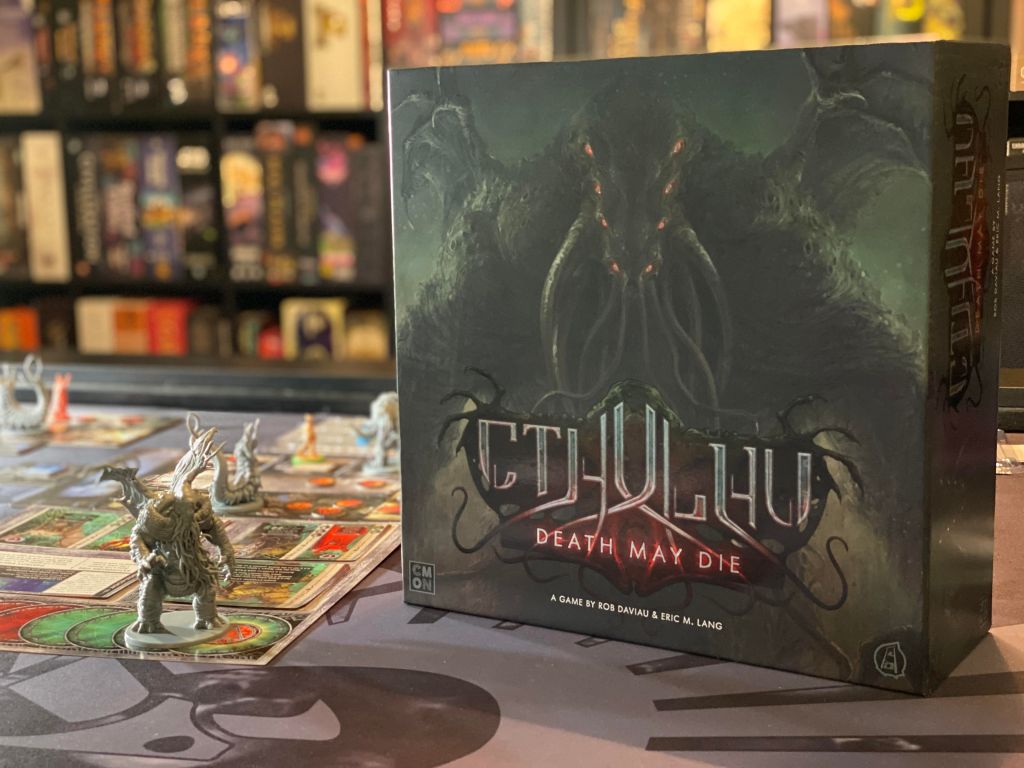
Origin Story
This is a game that I ALMOST didn’t buy. The kickstarter that is just now shipping out to all the masses just got delivered to me about a week ago and let me tell you, I’m glad I went in for it. Originally when I was perusing it online, I thought to myself, “ehhhh I could probably wait for retail on this one if it turns out to be good”. You see I already have so many Cthulhu themed board games from the Arkham Horror stuff to Cthulhu Wars. It’s a very saturated theme for sure and I was understandably hesitant to drop even more money on another Cthulhu game.
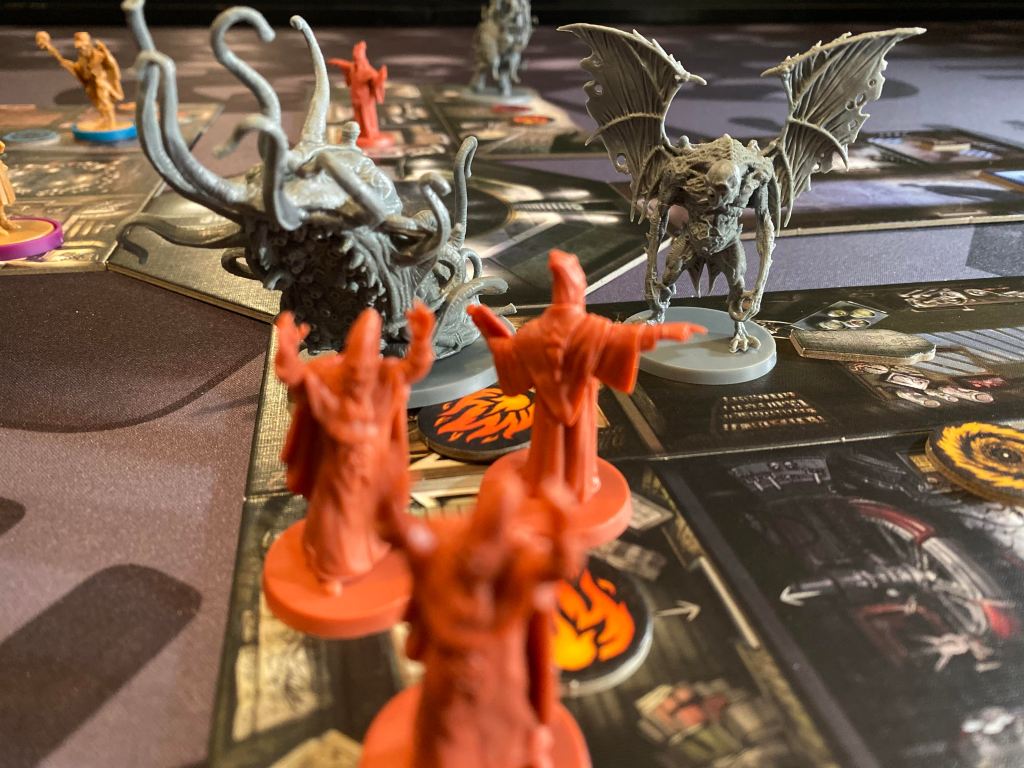
Well one day I was discussing the previous nights game of Betrayal Legacy with a buddy and we got to talking about how much we just adore Rob Daviau, the designer of Betrayal. I ended up bringing up Cthulhu: Death May Die (not knowing at that point that Rob had a hand in the design) and my buddy brought it up on kickstarter and started looking it over. “Ohhhh”, he says, “Rob Daviau designed this”. I mean that ALONE was enough for me to go just a little wild. But then I noticed that Eric Lang ALSO co-designed it. Eric Lang has designed a few of my favorite action style games such as Blood Rage and Chaos in the Old World.
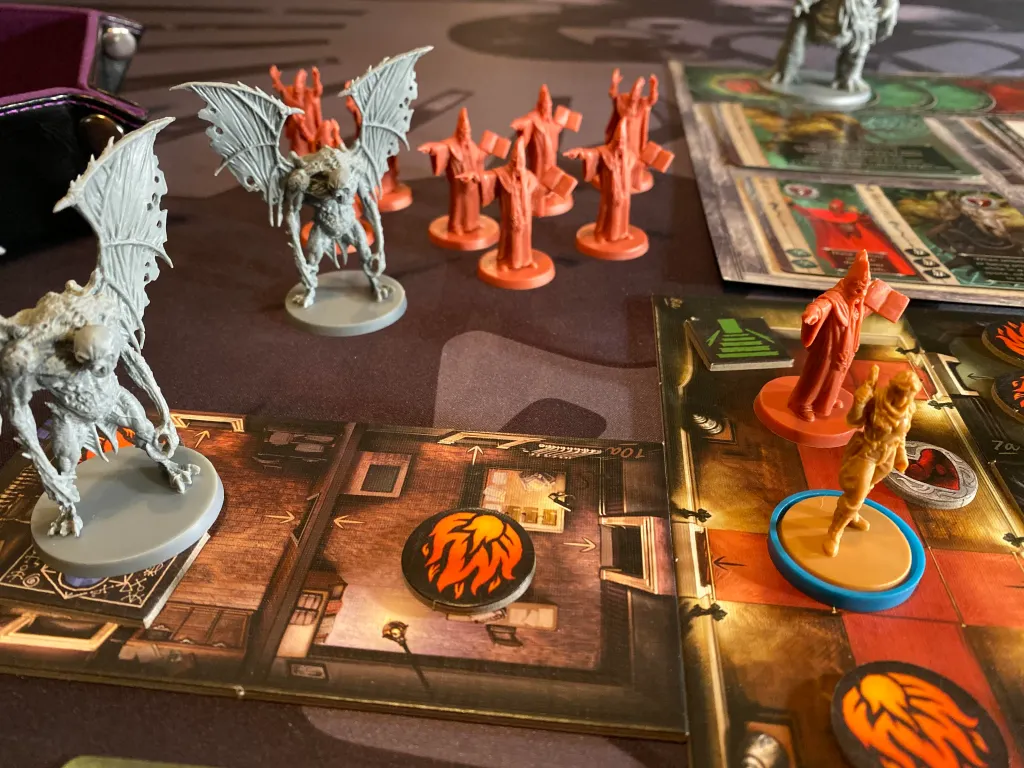
Needless to say, that was all it took for me to get it. And now a little over a year later I have had it on my table for a week straight going through each episode in the core box just to get a taste of how it plays. Read on to receive the full experience of this madness.
Overview of Gameplay
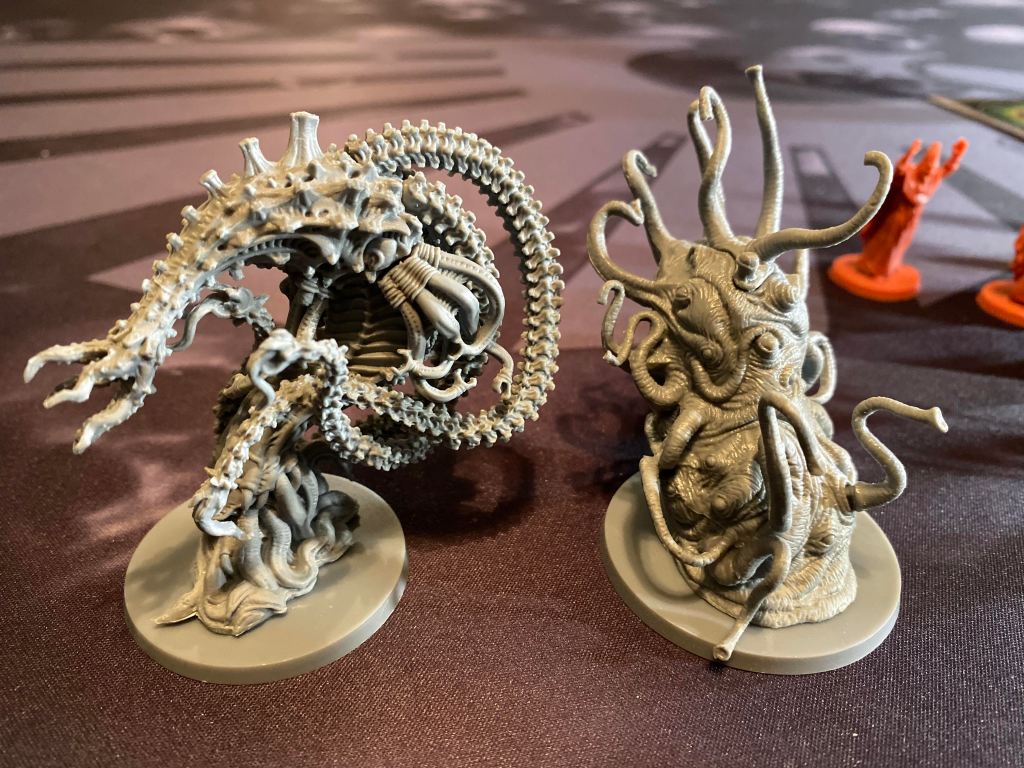
This is about as pure of an action game as you are going to find. There is very little story to be found here aside from the little snippets on the episode boxes that kinda give you an idea of what those pesky cultists are up to next. The setup is half the fun with the game as you can mix and match Elder Gods and episodes to your hearts desire to create a unique experience every game. In the core box you will find two Elder Gods, Cthulhu and Hastur, and six episodes. Each Elder God box comes with the God of course, its side minions, the cards for the mythos, minions and God and some tokens that play a small role on its mythos cards/God abilities. Now the episode you choose is where you get the unique tiled board set-up, the rest of the minions and the plot/point of the game. So, let’s recap, each of the six episodes provides a completely different board set-up, each with a unique purpose and playstyle. Then you mix in one of the two included Elder Gods to add that extra kick to the eldritch flavor.
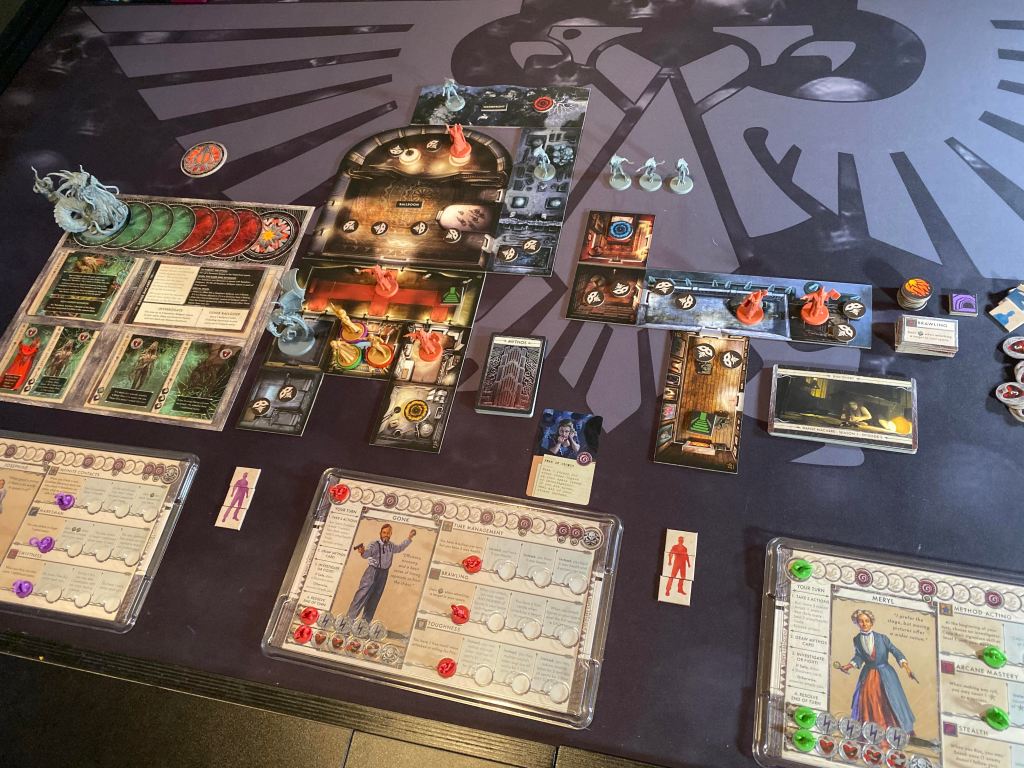
Once you get all that setup you still have to choose from a plethora of unique characters. Each one has three skills, one of which is completely unique from all the others. The other two skill could be shared and are pulled from a pool of six different skills. It goes without saying there is a TON of variability here.
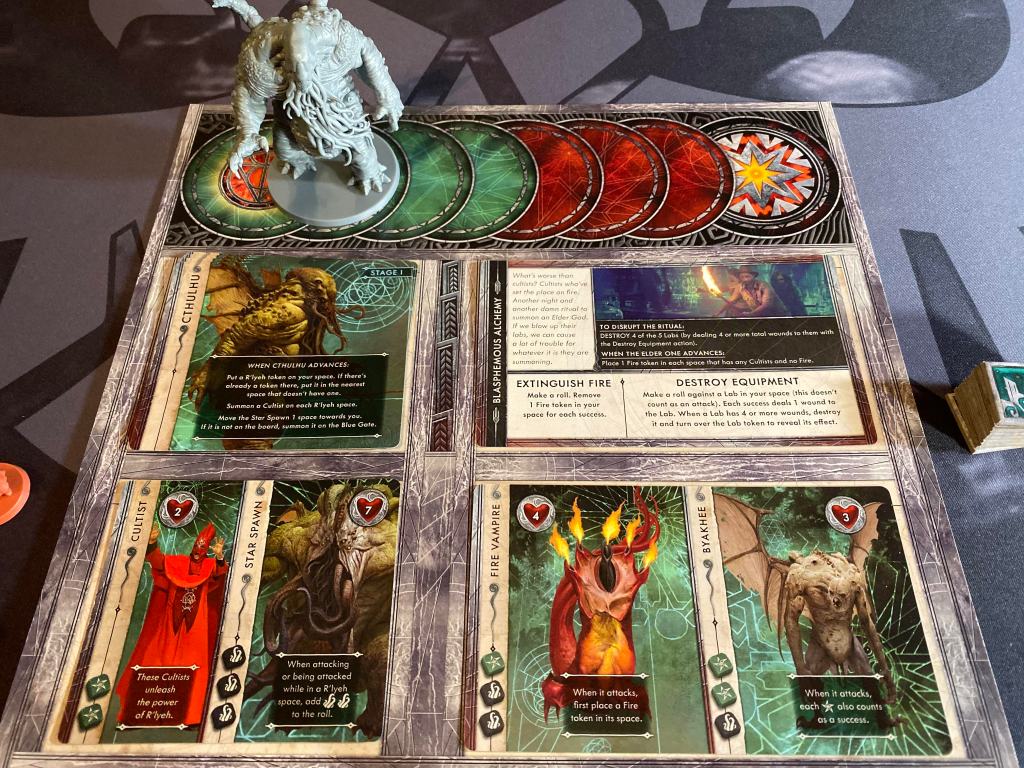
The gameplay is pretty straight forward. On your turn you take 3 actions consisting of movement, attacking, trading, resting or doing one of the two unique actions listed on the particular episode card. Once you are satisfied with you actions you draw one of those dreaded “Mythos” cards that these Cthulhu games are renowned for and suffer the consequences. These cards are also neat because at the beginning you shuffled the particular Elder Gods mythos cards in with the particular episodes mythos cards so you get a nice mix of each. After that is finished, if your character is in a zone free of enemies then you can draw an oversized Discovery card which usually is a help to you. These cards have equipment, companions and other items. However, if there are enemies in your zone then they get to attack! You roll dice based on their listed dice on their minion cards and possibly take wounds or insanity.
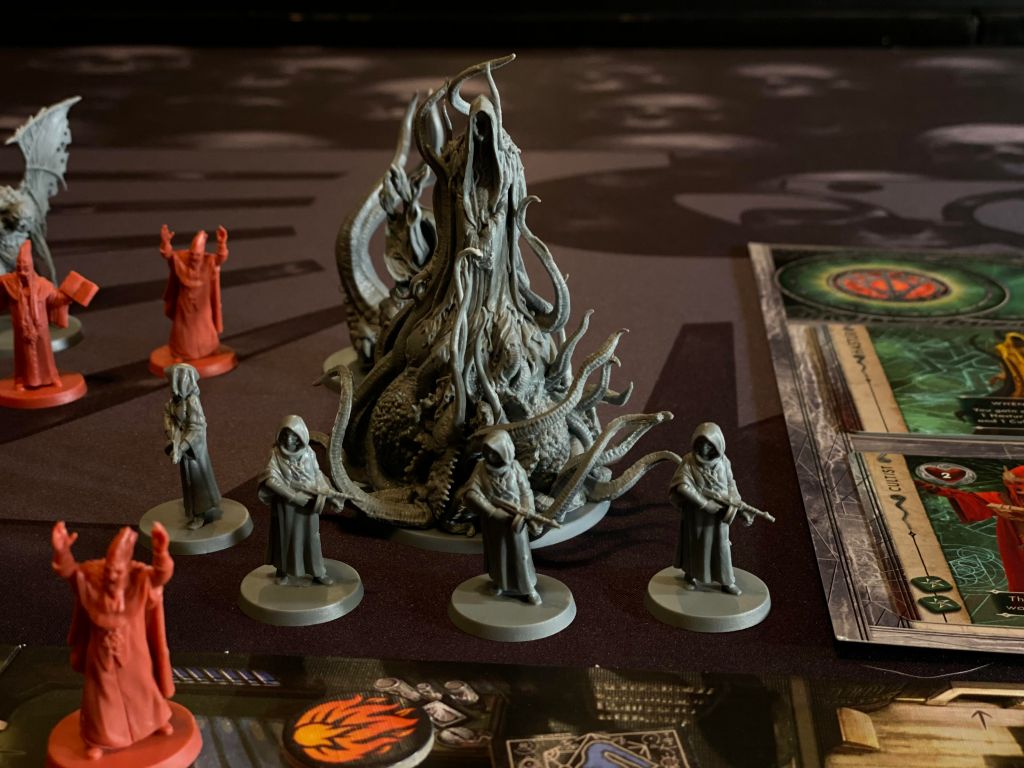
Now, let’s back up for a moment. Remember those nasty Mythos cards I mentioned earlier? Well after you resolve one it goes into a nice little snug discard pile…..that is, until three of them with a special summoning insignia gather there. Now at the very end of a players turn if there are three of those particular mythos cards in the discard then the cultists have furthered their summoning ritual and the elder god is one step closer to being brought into our world! When this happens, some nasty little thing will transpire based on whichever elder god you are playing.
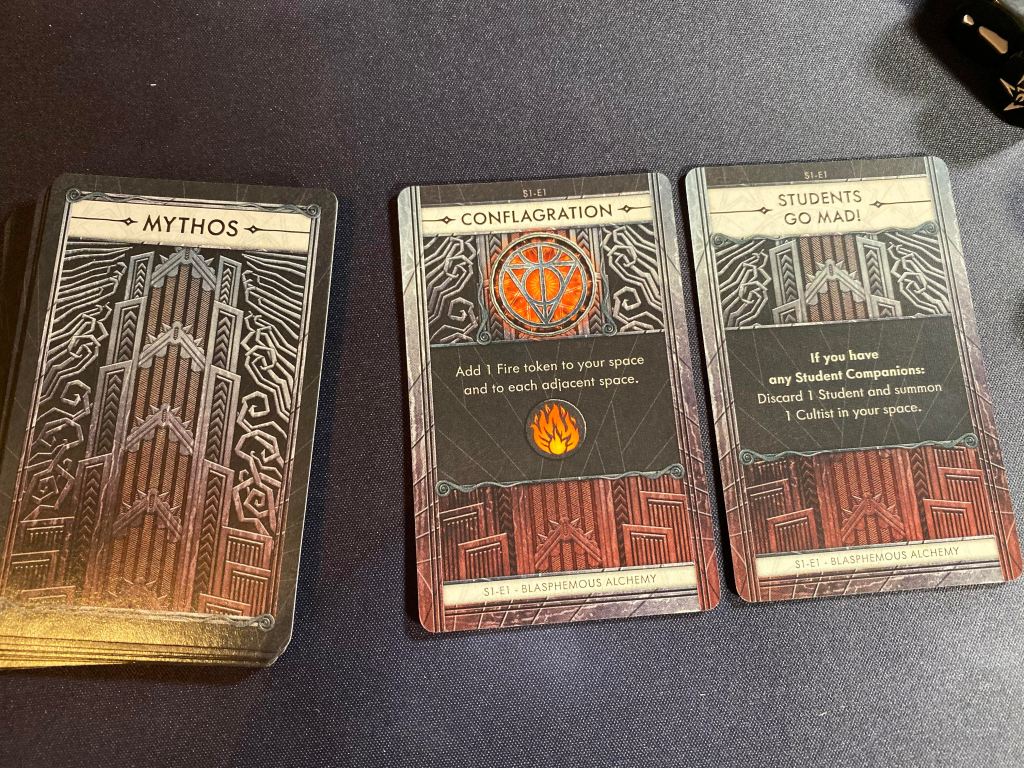
SO, your mission is to disrupt the cultists summoning and bring the elder god into our world before it has reached full power from the ritual. The exact requirements for disrupting the ritual differ between each episode and let me tell ya, they are COMPLETELY different regardless of which elder god you play with. Once the god gets to a certain point along the summoning track it will be brought into the world (main game board) regardless but will be invincible UNTIL you disrupt the summoning. Once that is done you just have to kill it, no easy feat considering it has four phases to go through. Once you do 12 damage to the first phase, you remove the phase 1 card to expose phase 2. Now, these phases are stacking so each new phases powers and dice for rolling ADD to those of prior phases. So……yeah. It’s a long, hard road and not an easy one to traverse. BUT, with enough determination and quite a bit of luck you may just come out on top.
Components/Game Board
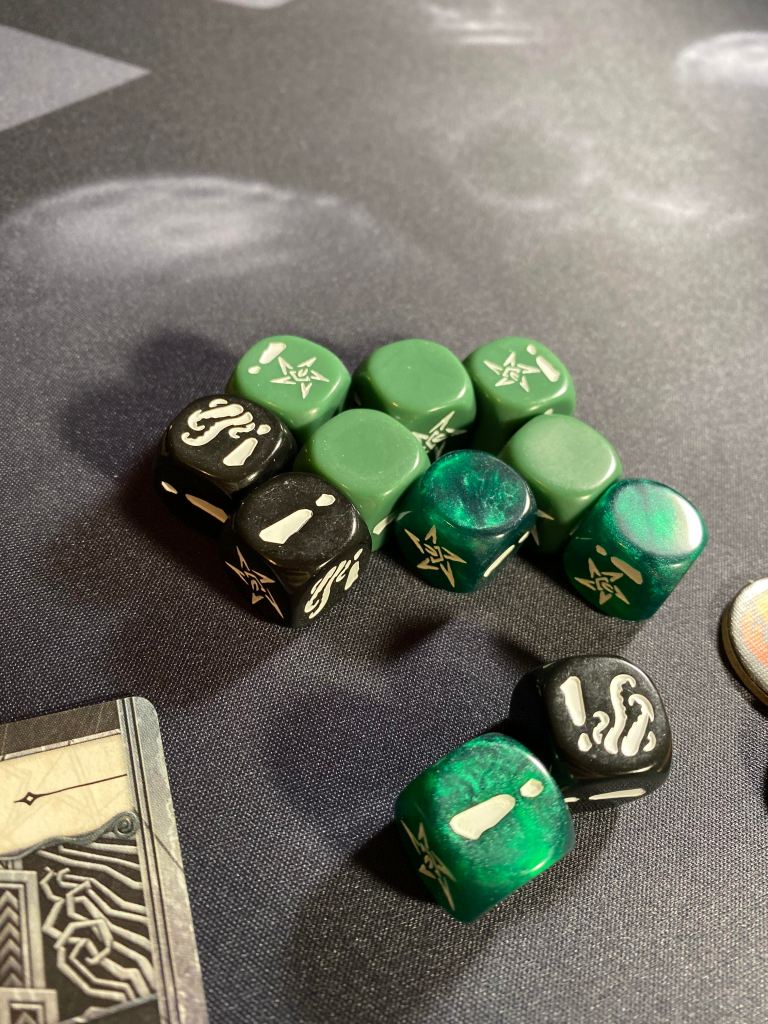
Overall the component quality is great as far as the materials used is concerned. The dice feel excellent in the hand and have nice custom images. The miniatures are above reproach with the elder god Hastur being a real standout here. Even the sculpts of each unique character mini look cool and the core box comes with a decent variety of enemies such as ghouls, Byakhee, a Shoggoth and a few more up to and including cultists of course. The card quality is also pretty nice although I do see some bowing in the larger cards although this is pretty common and is easily rectified with a quick bend in the opposite direction.
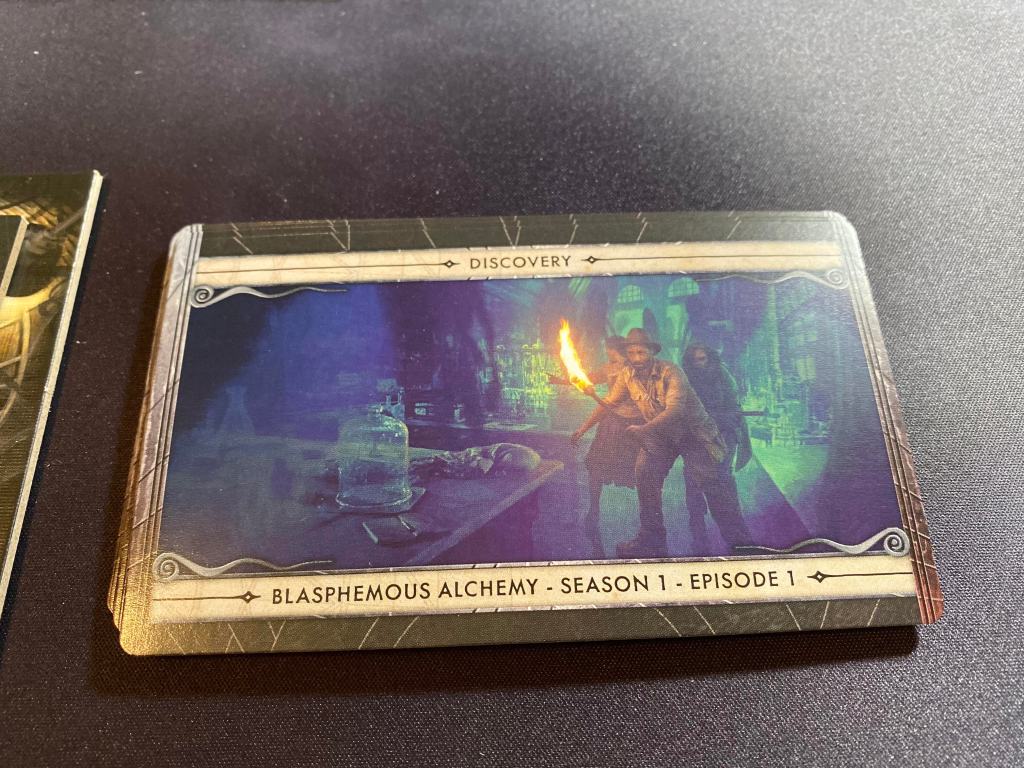
I do however have some complaints. First, my biggest complaint is the size of the board game tiles. The game comes with a decent selection of double-sided tiles so each setup is very different but they are SO small! At first you won’t think anything of it, but as you start progressing through the game more and more enemies appear and then starting moving……and piling up on these tiles that seem even smaller now that you have 4 cultists and a huge shoggoth all vying for space on a single space on a tile. It gets even more silly when the elder god itself comes out to the board literally taking up an entire location on a tile itself. In other words, make sure you are doing your best to keep the enemies thinned out or you will be running into some space issues.
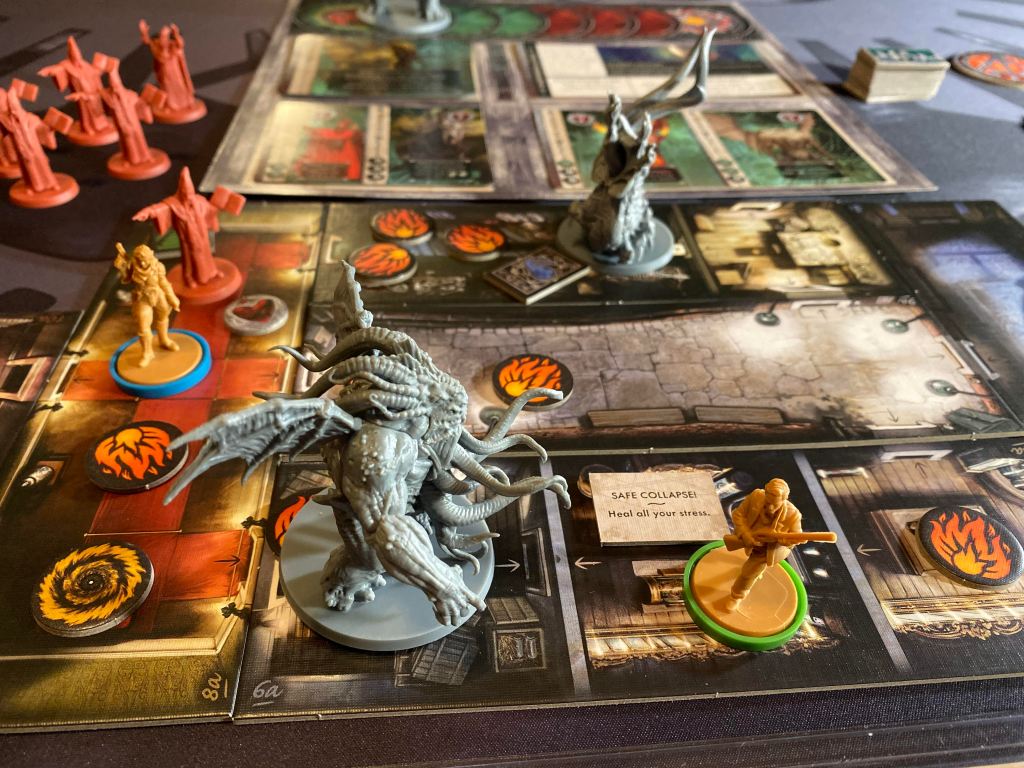
My only other complaint has to do with the player boards themselves. Now, personally I don’t have an issue with them as I received the kickstarter version that came with some nice little plastic playboard holders. These little guys hold the little tentacle markers (which I’m pretty sure are the EXACT markers used in the game The Others) perfectly aligned with the spaces on the players boards. I did try a game with out using them and it was less than perfect. With all the dice rolling that’s in this game you are sure to accidentally knock your mat, which will undoubtedly move your makers and then comes the guessing game of how much health/stress/insanity/which levels of each of the three powers you had. In any case I would highly recommend trying to track down some of these plastic holders for the character sheets.
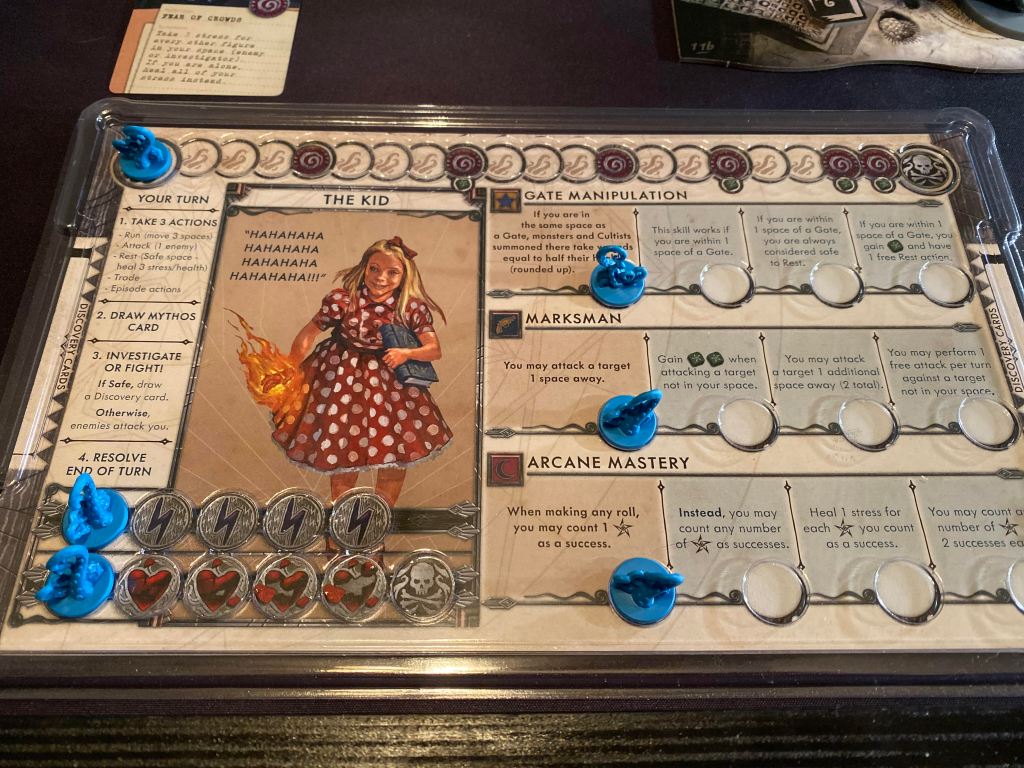
Box/Storage
I actually like the storage with this particular CMON game! This is a rarity for me as I usually don’t like CMON’s packaging method of cramming boxes within boxes but this one works. Each of the elder gods comes with its own special box that holds all its minis and cards. The episode boxes are all the same size and line up really nicely in the main box with a small plastic insert for the bigger monster minis. Below that lining the bottom of the box is a longer plastic insert housing the rest of the smaller, more humanoid minis such as the player characters. There are also spots in that insert to hold the dice, tokens and markers.
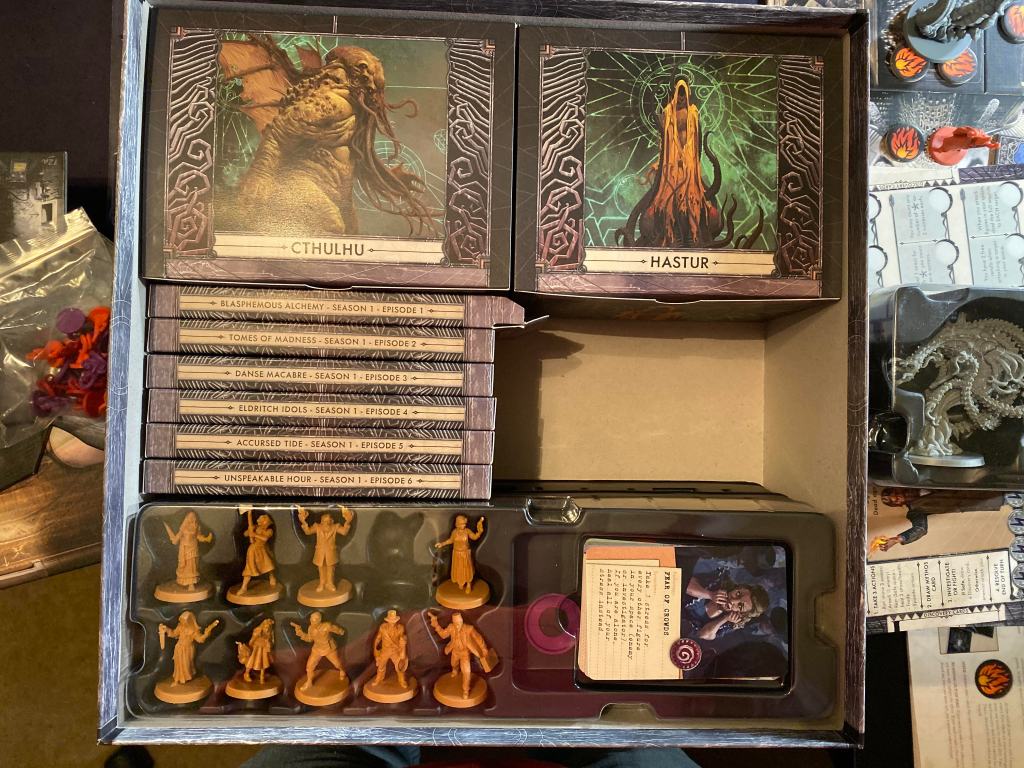
All the tiles and booklets lay on top of that and since everything in the box is contained in their own nice little boxes, there is no fear of stuff getting all mixed up and rearranged. It’s a really clever system how they incorporated so many different game styles and tokens in the game, but simplified them all into their own boxes and called them, “episodes”. Not only cleaning up the box but tremendously helping the storage solution. I really love it.
Visual Appeal /Theme
The game looks really good visually with all the artwork from the player mats to the board tiles all looking foreboding and sinister. The sculpts on the minis bring in a large amount of visual flare to the board game as well, especially when the elder god finally gets summoned to the main game board. I just wish the tiles were bigger to better appreciate the artwork.
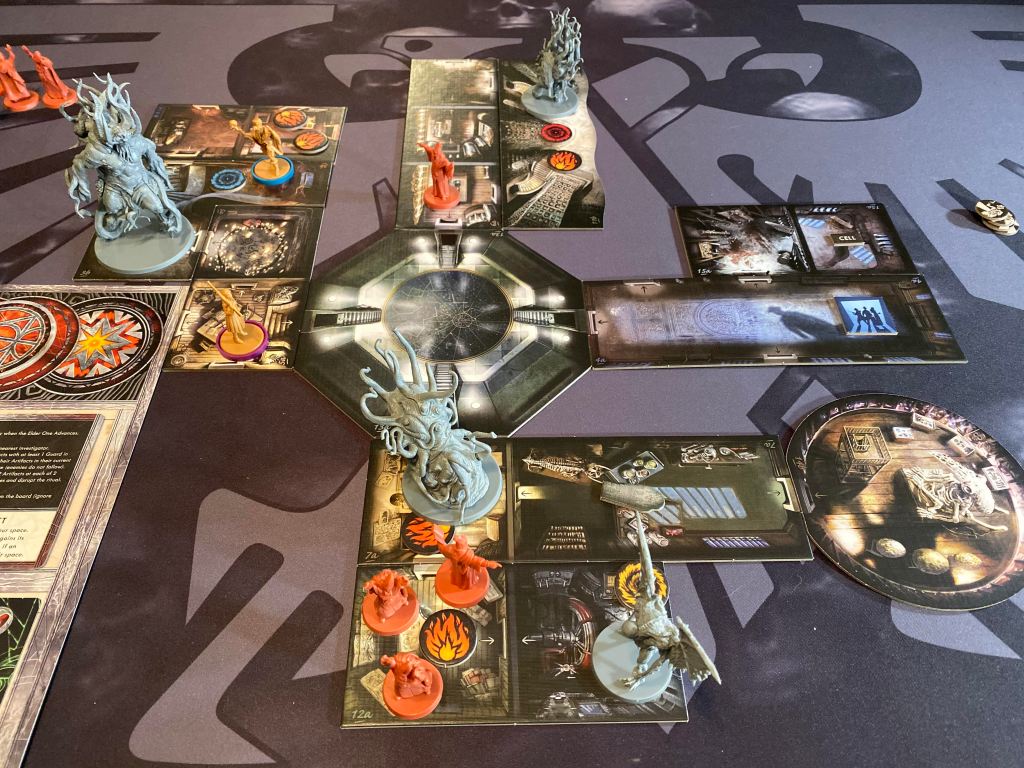
The theme is there and they do a decent job of making it seem like you are actually trying to stop a summoning. However, because there are almost no story elements at all, you end up just focusing on the action which I think lessens the theme to a degree. You start out reading the episode card and figuring out what you need to DO. Then it’s just do this and this and that until you accomplish said task, no story of any kind. Now, personally that’s completely fine with me in this instance because this game isn’t trying to be a super thematic game. If I want to play a Cthulhu game that oozes theme, I’ll whip out Arkham Horror 3rd Edition. If I want to run and gun having a action packed fight fest, then I’ll unleash Cthulhu: Death May Die.
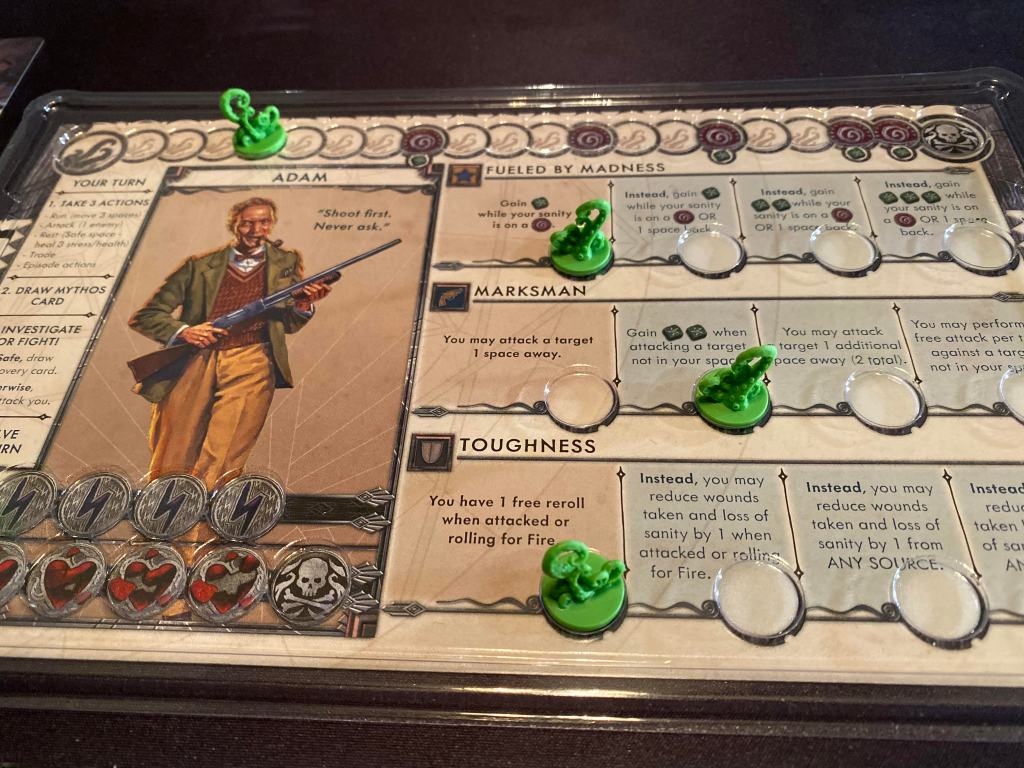
Rulebook
The rule book is short and sweet, very well written overall and it’s super SHORT. You can go through this guide in 15 minutes tops and come out having a great understanding on how to play. Heck the setups are more complex than playing the game, and just because each one is a bit different from the last. And that’s not to say the setup are complicated at all, cuz they’re not.
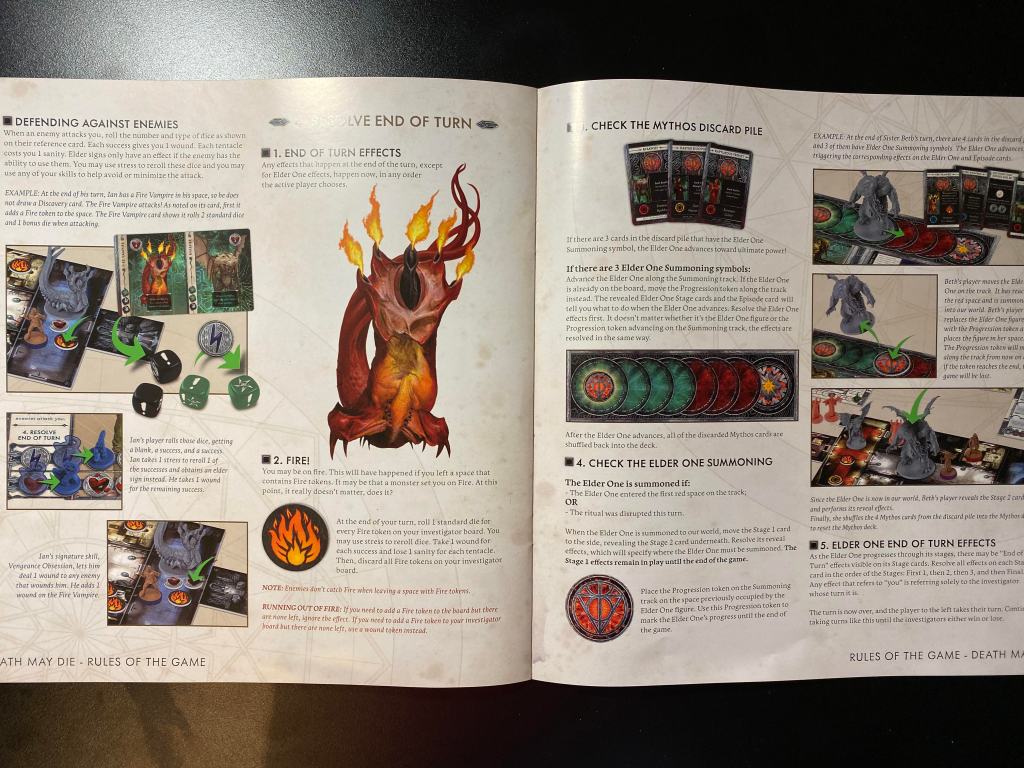
There are plenty of picture examples and it’s laid out in a very easy to read way. There are a few things that I do feel could have been explained a tad bit better though such as the required amount of enemies you are supposed to have per episode. All in the box or just what’s on the setup sheet? But for the most part this is a great manual with only a couple questions popping up afterwards.
Player Interaction/Fun Factor
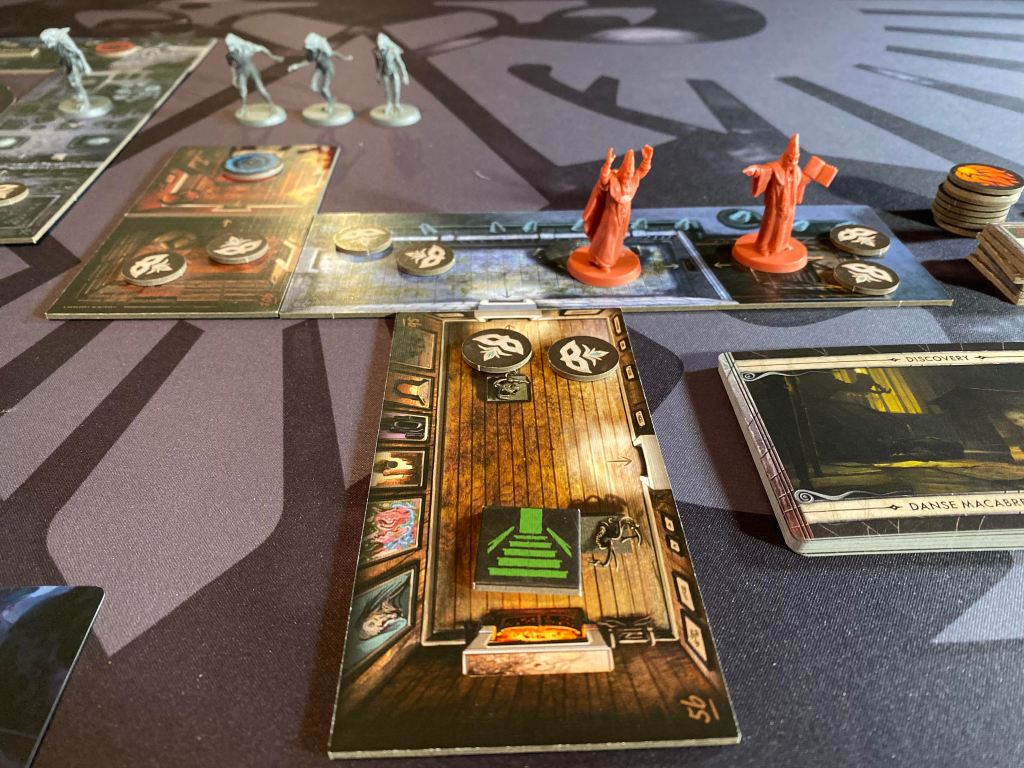
Being fully co-op there will be a bookoo of player interaction held within. Not only that but you do want to make sure you are communicating and working as a team, enlisting each others special skills to the maximum. This is not an easy game and you will want to make sure you are not missing a SINGLE action or ability. And let me tell ya, this game is FUN! The player mechanics are superb the way they all work together in perfect harmony. Each player has: Health, Stress, Insanity and three respective ability meters to track. You have 5 life, that’s it, cherish it, don’t take it for granted. For the love of Cthulhu, protect it!
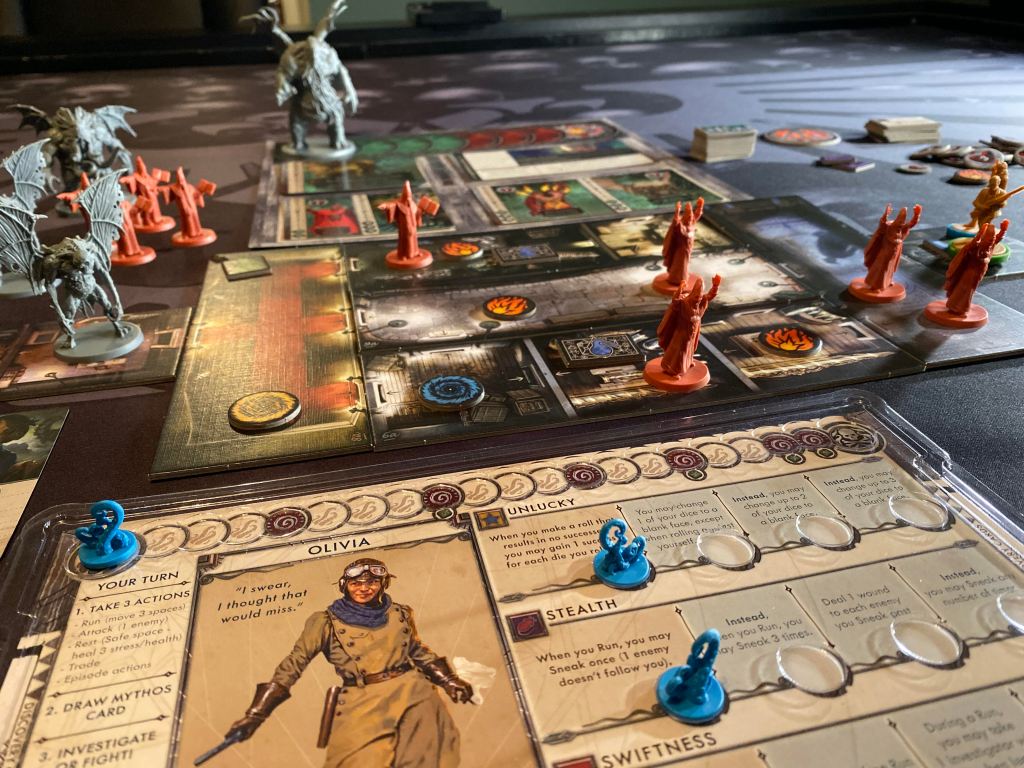
To do that you will utilize your Stress. You also have 5 Stress and for each stress you expend you can reroll a single die and this can be a literal game changer so make sure you are always keeping some extra stress available. Another really awesome mechanic to this game is the way that you use your insanity for the greater good. In other games like this when you go insane, well, bad stuff happens like you turn on your friends or burn a building down. In this game as you go more and more crazy, you actually get a bit stronger. You start unlocking even MORE dice to roll, you gain upgrades to your 3 abilities to customize your character a bit.
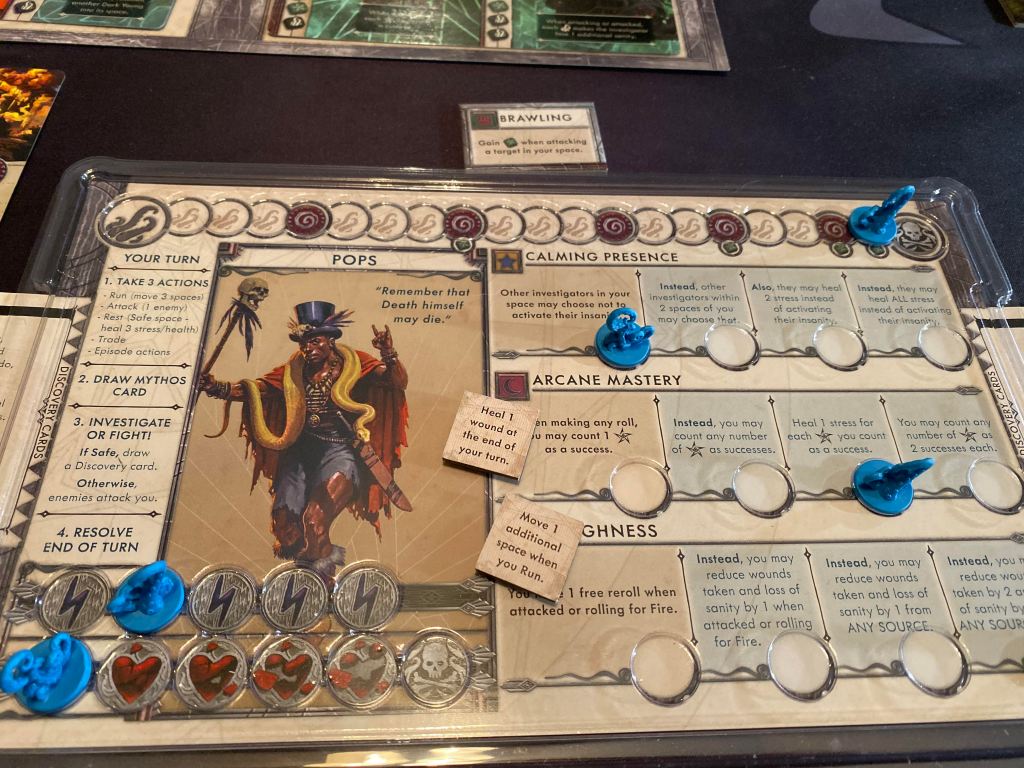
Now that’s not to say going completely insane is a 100% good thing here. If you ever reach the end of that insanity track, you’re dead. It’s a nice balancing act where you kinda WANT to go a little crazy just to prepare yourself for the epic final battle but not TOO crazy where the final god pushes you over the edge.
Optimal Player Count/Replay Value
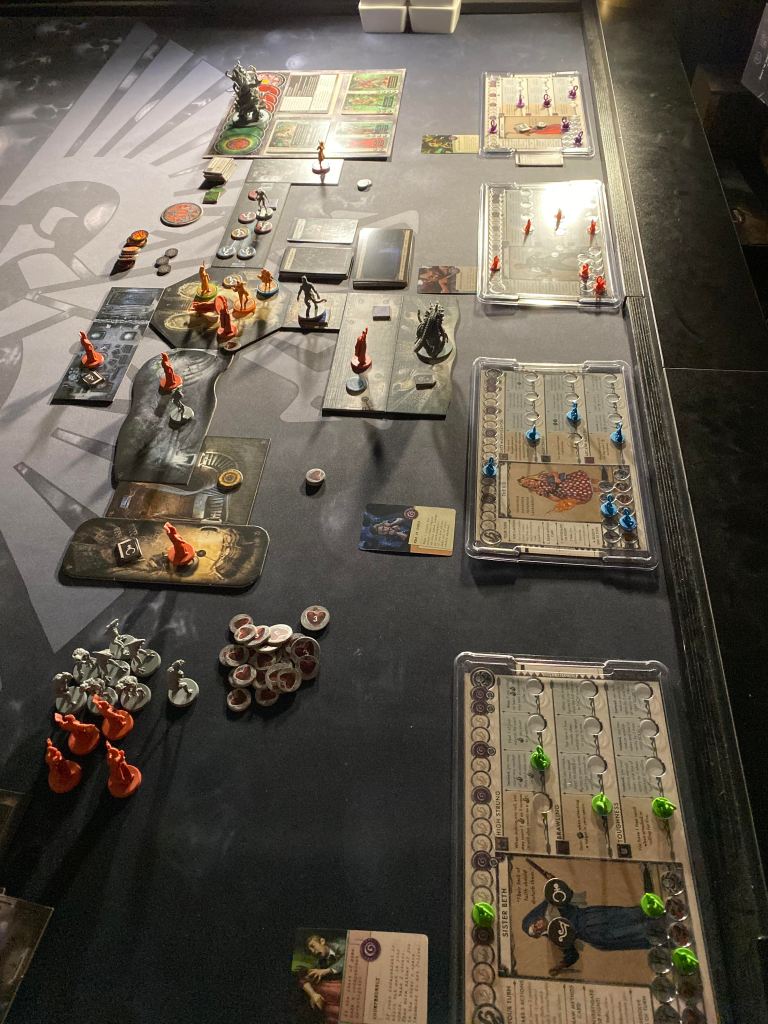
I say 3-4 players would be my pick for player count. You can play the game solo but you have to use 2 characters and alternate between them so it’s not true solo. And personally 2 players is just not quite enough to handle this game. I mean you can very quickly get overwhelmed with the hordes of minions and the final boss has the same amount of life and phases regardless player count. Three players does much better and four works pretty well too. Five players is also an option but you will run into a bit of downtime as each player does have 3 actions AND mythos card draws which usually manipulates something with the enemies and if the elder one advances, well then you have even more downtime to contend with.
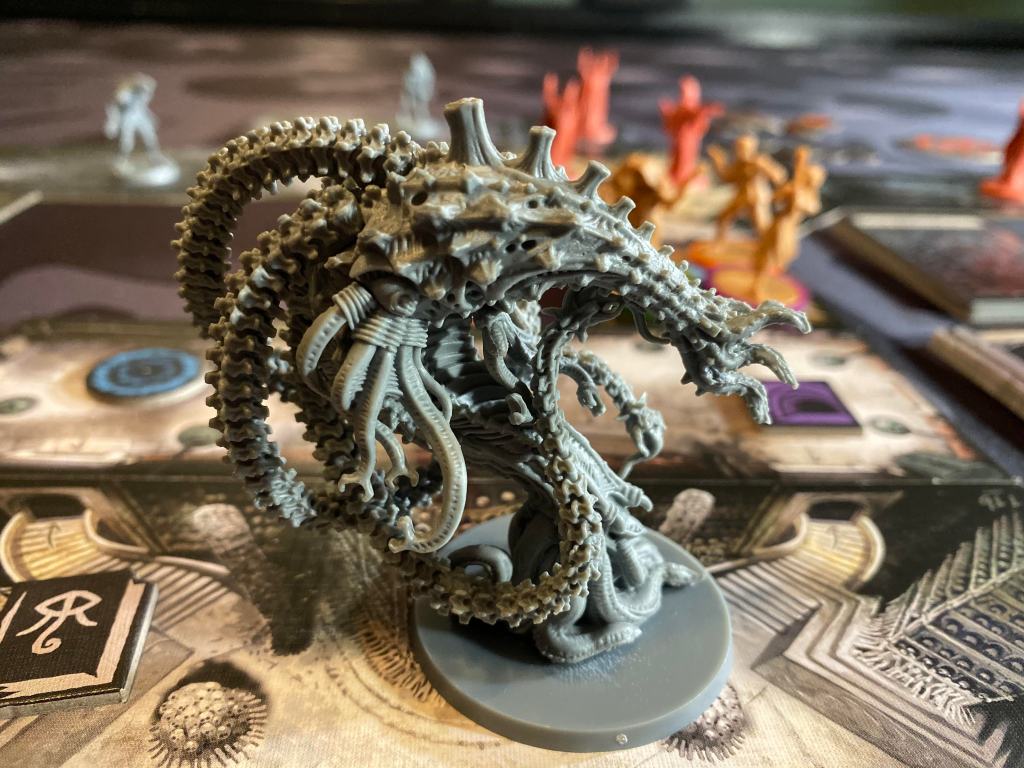
Good gravy. The replay value is mind blowing here. I already went through this but with six completely different play styles/missions to choose from, each with a different board setup you will have your hands full for awhile to say the least. And since each new elder god you throw into the mix also alters the game play a bit, that adds even more replayability. AND THEN, each player character is a bit different with their unique abilities. I mean, I have had a blast going through each different episode with the variable setups. This is also one that I highly recommend picking up a couple of the elder god expansions to add more variety to those in the games as the included two gods might feel samey after a few plays.
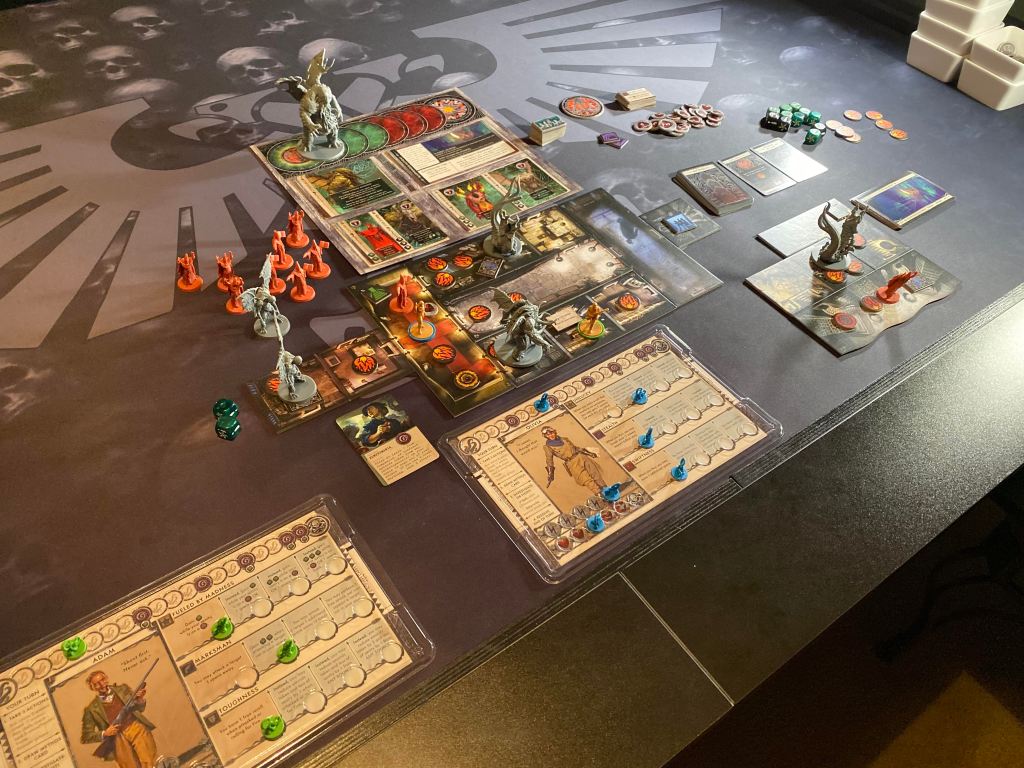
Positive Final Thoughts
Excellent gameplay and variable setups here. I simply love the way the player mats work with the actions and the insanity build-up. The miniatures look great and add a great deal to the overall presence of the game. The box storage is very cleverly done and for the most part the components are well done. The action gameplay here is second to none.
Negative Final Thoughts
The board tiles are much too small and the player mats without their holders are prone to knocking. Also, this game is EXTREMELY luck dependent. I mean I like some luck in my games to keep the tension up but this takes it to a whole new level. With having only five life, you need to make sure to always keep some Stress available for re-rolls and make sure you keep the enemies thinned out a bit. There have been times I got a bad mythos card draw (is there any other kind) and 4 enemies moved into my space and proceeded to knock my head against a wall until I died (simulated). The game actually will end for everyone if a player dies before the elder god is summoned which tells me they designed the game this way just because of the wildly swingy luck factor.
The Bottom Line
I mean, I love it. I love it so much more than I thought I would and I’m so glad that Rob and Eric teamed up and brought this to us. After my first couple of games I was worrying about the luck factor, but once you get the feel for the game and how to avoid those nasty situations it really isn’t THAT bad. But it can be if you’re not preparing, paying attention, holding your monkey paw. It’s an easy Fuzzy Llama Golden Seal of Eternal Excellence, and well deserved.
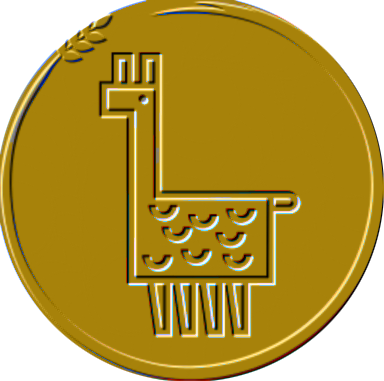
The Fuzzy Llama Golden Seal of Eternal EXCELLENCE
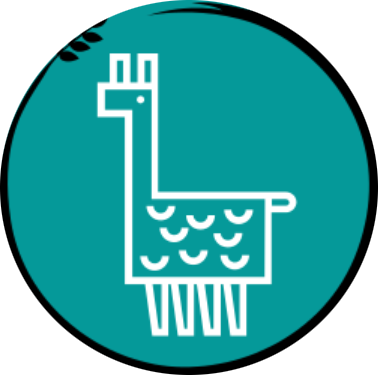
2 thoughts on “Cthulhu: Death May Die”